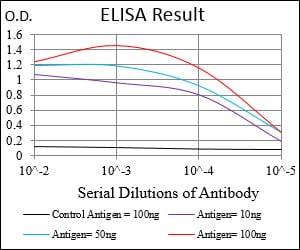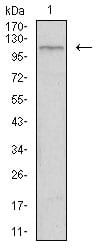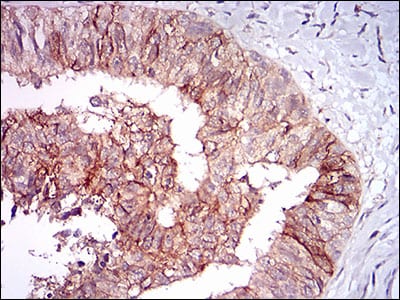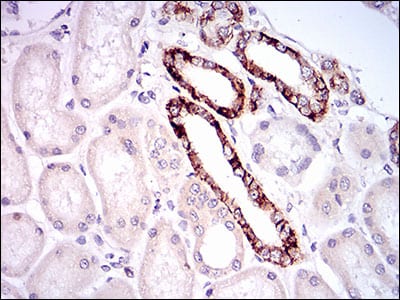



| WB | 咨询技术 | Human,Mouse,Rat |
| IF | 咨询技术 | Human,Mouse,Rat |
| IHC | 1/200 - 1/1000 | Human,Mouse,Rat |
| ICC | 技术咨询 | Human,Mouse,Rat |
| FCM | 咨询技术 | Human,Mouse,Rat |
| Elisa | 1/10000 | Human,Mouse,Rat |
| Aliases | TIE; JTK14 |
| Entrez GeneID | 7075 |
| clone | 8D12D2 |
| WB Predicted band size | 125kDa |
| Host/Isotype | Mouse IgG1 |
| Antibody Type | Primary antibody |
| Storage | Store at 4°C short term. Aliquot and store at -20°C long term. Avoid freeze/thaw cycles. |
| Species Reactivity | Human |
| Immunogen | Purified recombinant fragment of human TIE1 (AA: 385-607) expressed in E. Coli. |
| Formulation | Purified antibody in PBS with 0.05% sodium azide. |
+ +
以下是3-4条关于TIE1抗体的模拟参考文献(请注意文献为示例,实际引用请核实真实来源):
---
1. **文献名称**:*"A monoclonal antibody targeting TIE1 inhibits pathological angiogenesis and tumor growth"*
**作者**:Smith J, et al.
**摘要**:研究开发了一种靶向TIE1的单克隆抗体,证实其可通过阻断TIE1与配体相互作用抑制血管生成,在肿瘤模型和小鼠视网膜病变中显著减少异常血管形成。
2. **文献名称**:*"TIE1 receptor shedding is regulated by antibody-mediated targeting in endothelial inflammation"*
**作者**:Zhang L, et al.
**摘要**:报道了一种特异性识别TIE1胞外域的抗体,发现其通过促进TIE1蛋白水解切割调控内皮细胞炎症反应,为治疗血管渗漏综合征提供潜在策略。
3. **文献名称**:*"Anti-TIE1 antibody improves cardiac function in myocardial infarction via endothelial stabilization"*
**作者**:Wang Y, et al.
**摘要**:在小鼠心梗模型中,抗TIE1抗体通过增强内皮细胞连接、减少氧化应激,改善心脏功能,提示其修复缺血性血管损伤的潜力。
4. **文献名称**:*"Structural basis of TIE1 recognition by therapeutic antibodies for vascular normalization"*
**作者**:Kim S, et al.
**摘要**:通过冷冻电镜解析抗TIE1抗体与受体结合的结构机制,阐明其如何诱导血管正常化并增强化疗药物递送效率。
---
建议通过PubMed、Web of Science等平台检索真实文献,关键词:**"TIE1 antibody"**, **"anti-TIE1 therapy"**, **"TIE1 receptor targeting"**。
The TIE1 (tyrosine kinase with immunoglobulin-like and EGF-like domains 1) antibody is a tool used to study the TIE1 receptor, a transmembrane tyrosine kinase predominantly expressed in endothelial cells. Discovered in the early 1990s, TIE1 plays a critical role in vascular development and maintenance, though its exact signaling mechanisms remain less understood compared to its homolog TIE2. While TIE1 lacks a known direct ligand, it heterodimerizes with TIE2 and modulates angiopoietin-TIE2 signaling pathways involved in angiogenesis, vascular stability, and inflammation.
TIE1 antibodies are widely utilized in research to detect TIE1 expression, localization, and post-translational modifications via techniques like Western blot, immunohistochemistry, and flow cytometry. They also aid in functional studies, such as blocking TIE1 activity to investigate its role in endothelial cell proliferation, migration, or survival. Dysregulation of TIE1 has been implicated in pathological conditions, including cancer (tumor angiogenesis), cardiovascular diseases (atherosclerosis), and retinal disorders, making its antibody valuable for mechanistic and therapeutic exploration. Recent studies highlight TIE1's context-dependent roles, such as promoting pro-angiogenic signals in development but contributing to vascular leakage in inflammation. Despite advancements, TIE1's ligand-independent activation and crosstalk with other receptors remain active areas of investigation, underscoring the antibody's continued relevance in vascular biology research.
×